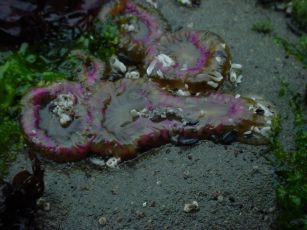
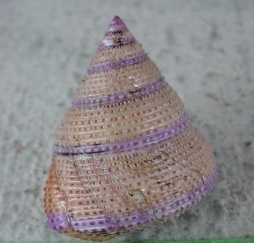
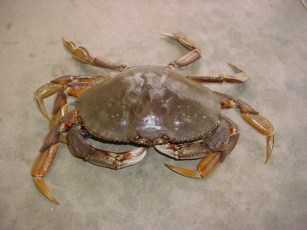
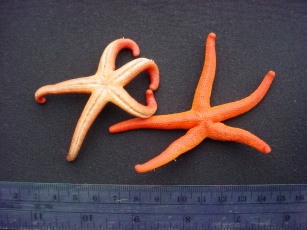
Invertebrates of the Salish SeaSponsored by the Rosario Beach Marine Laboratory, Fidalgo Island, Anacortes, WA; a campus of Walla Walla University |
 |
 |
 |
 |
| This page serves as an entrance to a fascinating look
at many of the
marine invertebrates found in and near the Salish Sea, especially Puget
Sound and the Straits of Juan de Fuca, Washington. Each
species has
a special page with its description, photos, and notes about its
natural
history plus observations we have made of the species. Most
of the
photos were taken of live animals, either in the field or in the lab on
animals that were then returned to the field. I am a
scientist and
teacher, not a professional taxonomist and I have been known to
mis-identify
a species on occasion, so if you see something that needs to be
corrected
please
contact me.
My sincere thanks
to the experts on various groups who have given me advice and helped
with
identification. You can also check out my main web page at https://people.wallawalla.edu/~david.cowles
If you know or think you know the group or name of your
species you
may quickly navigate directly to it by using the Alphabetic
or Systematic
indices; otherwise you
may use the dichotomous keys to find out what it is. Wherever
possible,
the keys are supplemented with definitions to terms and with pictures
of
relevant species and the parts being compared. You can also
go directly
to the glossary from nearly any page to look up other terms. Cautionary
note: Systematic classification of these species is continually
changing.
I try to keep up with these changes, but this site should not be
considered
authoritative for the latest systematic (taxonomic) classification.
|
Alphabetic List of Species and Groups |
Illustrated Glossary |
|
Systematic Index(Organized in Systematic order, alphabetically under phyla) |
Annotated Bibliography |
|
Key to Species--Starting with Recognizable Group(Starts with Phylum, Class, or other recognizable group, which are listed alphabetically by phylum) |
Other Web Resources |
|
Key to Groups of Invertebrates(Start here if you don't know what kind of animal it is or what group an animal is in) |
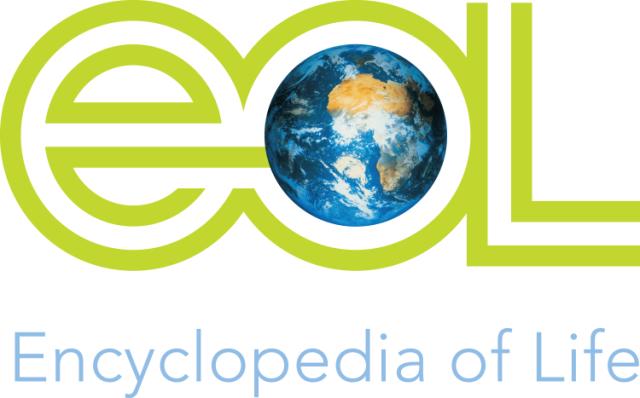
Content partner to the Encyclopedia of Life |
|
What is the Salish
Sea and where is the
|
Contributors to this Project |
|
| Introduced Species
and Species of Concern in the Salish Sea
(Covers only marine invertebrates) |
Send me Feedback(comments, corrections, observations, permission to use photos) |
|
| Instructions on how to use a dichotomous key |
I've been interested in this for a long time! (photos) |
|
| Rosario
Environmental Data
A collection of physical measurements of the Rosario Beach Marine Laboratory environment, including year-long measurements of temperature in the Rosario Bay water, on intertidal rocks with different tide heights and exposures, and light level and temperature in the air. |
||
|
The key currently
contains more than 450 species in
17 Phyla, 80 Orders, and 225 Families.
Keys to Species, Starting By Recognizable Group (Arranged Alphabetically by Phylum):In the list below, just click on the taxonomic level that you wish to jump directly to. Phyla are listed in alphabetic order.Phylum Annelida: Segmented worms Class Polychaeta Phylum Arthropoda:
Crustaceans and Chelicerates
Phylum Brachiopoda: Lampshells Phylum Chordata
Phylum Cnidaria:
Phylum Ctenophora: Comb jellies Phylum Echinodermata
Phylum Echiura: Echiuroid worms, spoonworms Phylum Entoprocta: Entoprocts Phylum
Hemichordata:
Hemichordates
Phylum
Mollusca:
Phylum Nemertea: Ribbon or proboscis worms Phylum Platyhelminthes:
Flatworms
Phylum
Porifera:
Sponges
Phylum
Sipuncula:
Peanut Worms
Page created by Dave Cowles, 6-2002
Salish Sea Invertebrates web site provided courtesy of Walla Walla University |